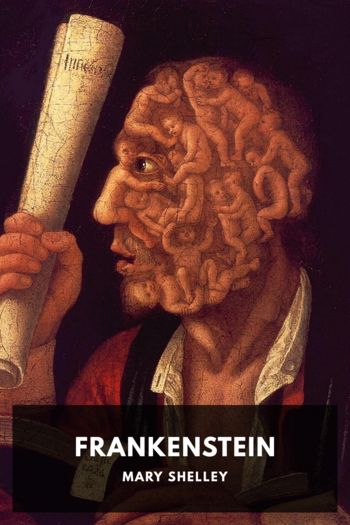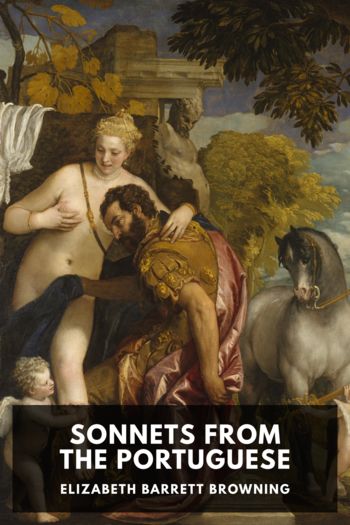Two-Way Mirror, Fiona Sampson [children's ebooks online .txt] 📗

- Author: Fiona Sampson
Book online «Two-Way Mirror, Fiona Sampson [children's ebooks online .txt] 📗». Author Fiona Sampson
This highly active imagination is badly in need of an outlet. Elizabeth starts to contemplate a long narrative poem. Yet here too her mind turns first to Napoleon but then to Joan of Arc and, ‘I turn myself wistfully towards Joan. Perhaps my original sin of mysticism is struggling towards her visions’, she tells Miss Mitford, ‘My belief is that she was true.’ She goes on, ‘Did you ever hear of Stilling, the German’s, book upon Pneumatology? […] you & I—believe everything—and Heinrich Stilling wants us to believe more than everything—.’ For some weeks she fixates on this work arguing for the existence of a spirit world, Johann Heinrich Jung-Stilling’s Theory of Pneumatology, loaning her own copy first to Miss Mitford, and then to Miss Mitford’s friend Mrs Niven.
Not surprisingly, the poems she’s currently writing increasingly explore this new territory. In ‘Rhapsody of Life’s Progress’,
We are borne into life—it is sweet, it is strange.
We lie still on the knee of a mild Mystery.
Despite all this, Elizabeth’s actual poetic voice is becoming steadily clearer and fresher. Gone are the contorted pseudo-Greek metrics, replaced in poems like ‘Wine of Cyprus’ and ‘A Lay of the Early Rose’ by newly fashionable ballad and song forms familiar from popular culture. More modern still is her use of her female narrators. Of course, women as protagonists in verse – from Penelope in Homer’s Odyssey to Geoffrey Chaucer’s fourteenth-century ‘The Wife of Bath’ or, two centuries later, Edmund Spenser’s The Faerie Queene – are nothing new. But the female lyric voice is a radical departure. Lyric poetry’s persona is necessarily both personal and universal: when I read a poem, I step into that poem’s ‘I’. Creating an illusion of plunging into intimacy with the female psyche, Elizabeth’s new narrative poems are ‘spoken’ by women characters, like the lover of the great sixteenth-century Portuguese poet Luís de Camões (‘Catarina to Camoens’) or the eponymous ‘Bertha in the Lane’, whose stories highlight the female identity of their ‘voice’, and of the poet’s voice too: after all, they aren’t being ventriloquised by male poets. And of course sometimes she also simply writes in the female first person without ‘dressing up’ in character.
In the twenty-first-century none of this is new. We’ve seen the female lyric I be prayerful with Emily Dickinson, self-flagellating with Sylvia Plath, witness to history with Anna Akhmatova. But radical writers change their own zeitgeist, not ours. Or rather: they already changed ours, back when they changed their own. In the 1840s, when none of these poets has yet started work, Elizabeth’s voice is radical and exciting. And without the changes she’s effecting, none of their poetry might have been written.
Led by description and story, the newly narrative verse that she and fellow poets like Tennyson and Browning are writing is freshly founded in the lived world of interpersonal experience. These innovative Victorian fables in verse aren’t only more emotionally and intellectually accessible than Romantic poetry, they’re also a great deal more respectable. Lord Byron’s narrative epics, Childe Harold’s Pilgrimage and Don Juan, turned him into an international literary celebrity in the early decades of the century; but neither is exactly suitable matter for the new domestic habits that see reading aloud become family entertainment. Elizabeth’s mid-century generation are making poetry accessible to a society being rapidly reshaped by the ‘family values’ the new queen has brought to public life since her accession in 1837. And so, as Moxon publishes Elizabeth’s Poems (1844), and she returns to planning the verse novel that will become Aurora Leigh, she specifically envisages a cleaned-up Don Juan to ‘touch this real everyday life of our age, & hold it with my two hands’:
I want to write a poem of a new class, in a measure—a Don Juan, without the mockery & impurity […]—& admitting of as much philosophical dreaming & digression (which is in fact a characteristic of the age) as I like to use.
Being ‘characteristic of the age’ is a form of social responsibility. Reading is no longer a hobby only of the elite. Literacy is slowly increasing as primary-level education for all gradually turns into first a church and then a state concern. In April of this year, at a private prayer meeting on Grays Inn Road, four ordinary Londoners create the Ragged School Union which, chaired by the 7th Earl of Shaftesbury, will found more than two hundred schools for destitute children over the next eight years – including some that Arabella will dedicate herself to. And so, although what Richard Hoggart a century from now will call the ‘massification’ of (pulp, tabloid) reading matter that shapes working-class culture is still in the future, fiction and poetry are beginning to find mass audiences. Charles Dickens, for example, though six years younger than Elizabeth, is already enjoying huge popular success and royal approval.
Writing for this emerging readership doesn’t mean dumbing down. But it works best when mainstream values are genuinely shared. Elizabeth and her poetic peers are thoroughgoing Victorians in turning their back on the Romantic vision of poets as prophetic exceptions, Shelley’s ‘unacknowledged legislators of the world’. Instead, they view poetry as speaking to the special, quasi-spiritual, part of every individual, ‘reaching past nature unto God’, as Elizabeth put it in The Athenaeum. Poetry is still exceptional, but it plays its special part within each life. The democratising, flattening effect of this has more than a little in common with the congregational, Nonconformist Christianity that the Barretts by now thoroughly espouse.
As a result, Elizabeth and the poets like her are explicitly trying to give their everyman and everywoman reader a taste of beauty. (There are some striking parallels with how, at the ‘other end’ of the religious revival, Victorian High Anglicanism is using liturgical ‘smells and bells’, or extravagantly ornamented new builds by Gothic Revivalist prodigy Augustus Pugin, to





Comments (0)